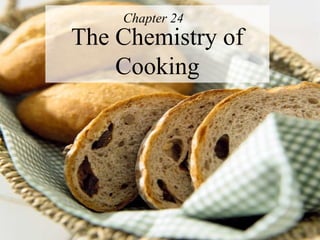
C24 the chemistry of cooking
- 1. The Chemistry of Cooking Chapter 24
- 4. Methods of cooking food Using Electromagnetic waves (e.g. Microwave cooking ) Using oil or fats (e.g. deep frying) Using moist heat (e.g. boiling, pressure cooking) Using dry heat (e.g. grilling, baking)
- 11. Composition of a wheat grain The endosperm contains the most starch within the wheat grain. The bran contains lots of fibre and small amounts of proteins, fats and vitamins. The germ is the embryo within the kernel that contains high concentrations of proteins and essential nutrients such as vitamin E, folic acid, thiamin, minerals and fatty acids.
- 18. Important ingredients in baking Ingredient Description Flour This provides the bulk of the baked item. For baking bread, wheat flour, which is high in gluten , is usually used. Gluten (protein) is the substance that gives bread its fine texture and supports the rest of the ingredients during rising. Yeast Yeast is a fungi that feeds on starch and sugars, releasing CO 2 , alcohol and sugar. The CO 2 bubbles give the dough a light, airy texture. Fat Fat gives a softer texture and helps prevent the CO 2 bubbles from escaping from the mixture too soon. Sugar Sugar provides a direct food source for the yeast, improving its action.
- 19. Important ingredients in baking Ingredients Description Baking soda Releases CO 2 according to the equation: 2NaHCO 3 -> Na 2 CO 3 + CO 2 + H 2 O However, as this also produces a strong base, Na 2 CO 3 , which has to be neutralised, baking powder is usually used instead. Baking powder Baking powder is baking soda with acid added. This neutralises the base and produces more CO 2 according to the following equation: NaHCO 3 + H + Na + + H 2 O + CO 2 Egg Beaten egg white, like fat, helps to retain gas bubbles, while egg alone acts as a binder. Salt Salt adds flavour, and strengthens soft fat and sugar mixtures.
- 26. Effect of heat on Vitamin C Vitamin C is highly unstable and sensitive to heat, oxygen, pH, light and traces of copper. It is easily destroyed during cooking, preparation and storage methods. Oxidation of Vitamin C takes place rapidly when food is cooked at high temperatures . The longer the food is cooked, the more the vitamins are lost. Vitamin C is also a water soluble vitamin . Thus, it leaches into the cooking water and will be lost if poured away. Chapter 24: The Chemistry of Cooking
- 27. Action of sodium hydrogencarbonate on Vitamin C Sodium hydrogencarbonate is sometimes added to fruits and vegetables to remove pesticides or preserve the green colour. However, as it is amphoteric , it reacts with Vitamin C in a neutralisation reaction to form salt and water. The equation for the neutralisation reaction is as follows: C 6 H 8 O 6 (aq) + NaHCO 3 (aq) -> C 6 H 7 O 6 Na(aq) + H 2 O(l) + CO 2 (g) The ionic equation is therefore: C 6 H 8 O 6 (aq) + HCO 3 - (aq) -> C 6 H 7 O 6 - (aq) + H 2 O(l) + CO 2 (g) Chapter 24: The Chemistry of Cooking